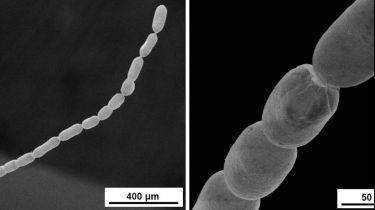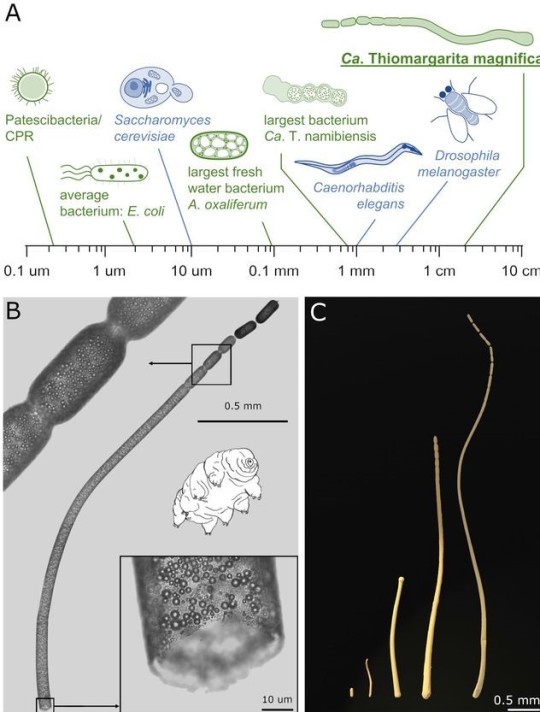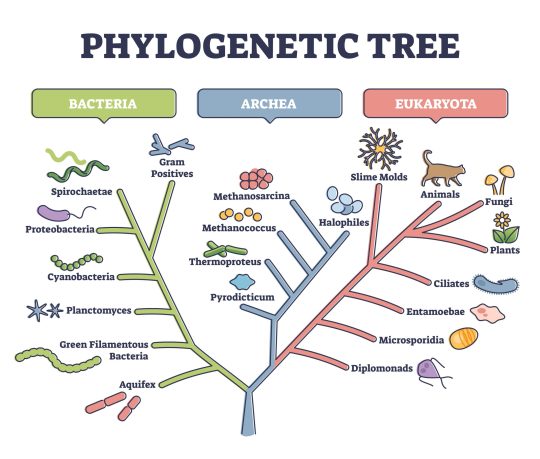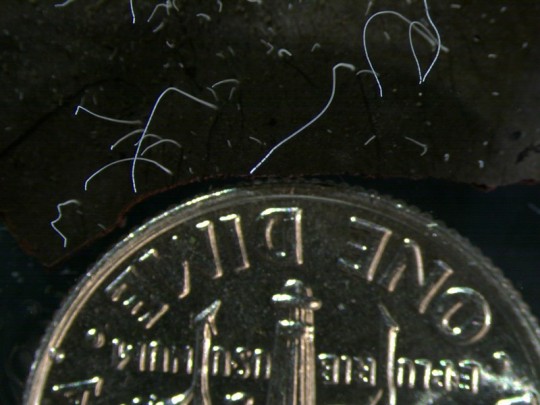#Thiomargarita
Text
Dünyanın En Büyük Bakterisi Keşfedildi
Dünyanın En Büyük Bakterisi Keşfedildi
Dünyanın En Büyük Bakterisi Keşfedildi
Bilim insanları Fransız Antilleri’indeki Guadelope adasında, tropikal bataklıklarda çürüyen mangrov yapraklarında dev bir bakteri türü buldular. Thiomargarita magnifica isimli bu bakteri yaklaşık 1 cm uzunluğunda normal bakterileri kıyasla 50 kat daha büyük.
Science Dergisinde yayınlanan makaleye göre bakteri karmaşık bir yapıya sahip. Binası zarla bağlı…

View On WordPress
#Dünyanın En Büyük Bakterisi#Dünyanın En Büyük Bakterisi bulundu#Dünyanın En Büyük Bakterisi keşfedildi#Thiomargarita magnifica
0 notes
Text
The Weird Microorganism Iceberg

I basically made this on an impulse, please don’t take it too seriously. Feel free to suggest more organisms!
Explanations under the cut.
Tardigrades: You probably all know this one. Commonly said to be polyextremophiles, but this isn’t actually true; while they can survive extreme conditions, they don’t thrive in them. Something you might not know about them is that all of their body segment genes are equivalent to arthropod head genes — meaning they are basically walking heads.
Demodex: Eyelash mites.
Diatoms: Geometric silicon shell creatures.
Nylon-eating bacteria (Paenarthrobacter ureafaciens KI72): Exactly what it says on the tin.
Myxozoa: Single-celled parasitic cnidarians. Lack digestive systems, circulatory systems, gonads, and even muscles in some species. Also may or may not be autonomous cancer cells.
Thiomargarita: The only macroscopic bacteria. Honorary microorganisms for the purposes of this image.
Wolbachia: Parasitic / mutualistic bacteria genus that has created numerous insect species through their effects on reproduction. (Infected females can become capable of parthenogenesis, while infected males are either killed, turned into females, or limited to reproducing only with females infected by the same strain.)
Deinococcus radiodurans: A bacterium which unofficially holds the title of “most extreme extremophile”. Can survive incredibly high doses of radiation, as well as high acidity and very low temperatures.
Dicyemida: Symbiotic (once mistakenly thought to be parasitic) animals that live in cephalopod kidneys. Have alternation of generations and used to be known as “Rhombozoa” (“rhombus animals”).
Facetotectans: Parasitic crustaceans with an unknown adult form. Attempts to artificially induce metamorphosis only produce another juvenile stage, as far as anyone can tell.
Metal-breathing bacteria: Bacteria which use nanowires to accept electrons from metals.
Limnognathia: One of the smallest animals, and has 15-part extensible jaws.
Disulforudis audaxviator: The only known organism to comprise a single-species ecosystem. Lives over a mile underground and feeds off the byproducts of radioactive decay.
Salinella salve: Possibly nonexistent simple animal, allegedly cultured by Johannes Frenzel in 1892 but never found by anyone else.
Warnowiids (Warnowiaceae): A family of dinoflagellates which have modified some of their organelles into an eye… which somehow works well enough for them to aim their stingers at prey, despite them having no brain (or even other cells) to process the images.
Haloquadratum walsbyi: A square that lives in salt.
Dicopomorpha echmepterygis: The smallest known insect, a parasitoid wasp smaller than a Paramecium.
Hemimastigophora: A group of organisms recently discovered to be an early-splitting branch of the eukaryotes.
Monocercomonoides: A genus of “excavate” “protists” (both terms are polyphyletic, lol) that lack mitochondria… or even the genes for them.
Parakaryon myojinensis: The only complete incertae sedis, for which not even the domain is known. Has an odd mix of eukaryote and prokaryote-like features, leading to speculation that they represent a second incidence of endosymbiosis (aka Eukaryota 2.0). Also my blog’s namesake.
Collodictyon: Considered unclassifiable for a long time. Not really that weird in and of itself, tbh.
Kamera lens: Continuing the theme, this is an alga that has proven weirdly difficult to classify despite having been known for centuries (though it’s been narrowed down to the Ochrophyta). Its funny name makes it a pain to look up.
Jeongeupia sacculi: Recently-discovered multicellular(!) bacterium. Unlike everything else on here, it doesn’t have a Wikipedia page (yet).
Meteora sporadica: “Protist” which moves by rowing with a pair of arm-like appendages. Another difficult-to-classify organism, although a study from earlier this year suggests they are related to the Hemimastigophora.
Kakabekia barghoorniana: Apparent Paleoproterozoic living fossil that looks like an umbrella.
Magosphaera planula: A sphere which splits apart into amoeba-like cells, observed by Ernst Haeckel in 1869. Also possibly nonexistent / misidentified.
82 notes
·
View notes
Text
Pseudomonadota
Group: Hydrobacteria; Proteobacteria
Gram-stain: Negative (mostly)
Etymology: For Pseudomonas aeruginosa. From the Greek "pseudes", meaning "false", and the neo-Latin "monas", in this context referring to a genus of eukaryotes (Monas) that Pseudomonas resemble. Hence, "false monas".
About: Pseudomonadota (formerly known as Proteobacteria) is a long-studied phylum, and just one of those that is difficult to describe in few words. It contains many famous infectious diseases: e. coli, salmonella, cholera, dysentery, gonorrhea... and the black plague.

Other famous bacteria in Pseudomonadota include those plastic-eating ones that you see in the news, as well as bacteria with special proteins that seed the growth of ice crystals and snowflakes. One species in this phylum is known for making a glue so strong that a tiny dab can suspend the weight of multiple cars. Then there is the parasitic/endosymbiotic genus Wolbachia, known for affecting the reproductive systems of their insect hosts, and can gift the females with a new ability to reproduce asexually (through parthenogenesis).
Pseudomonadota also contains the largest bacteria, with members that can be seen with the naked eye (up to an entire cm in length). The hair-like filaments in the below photo are Thiomargarita magnifica, the largest bacteria, and a Pseudomonadota.

But Pseudomonadota doesn't just go large: it also contains the bacteria with the smallest genomes. One such bacteria is an endosymbiont, candidatus Carsonella ruddii. They supply their hosts with essential amino acids, are present in every member of the host species, and are fully reliant on their hosts. This all means the species is probably in the process of becoming an organelle. A process just like this is what led to the mitochondria becoming a part of your cells! In fact, the ancestor of the mitochondria likely belonged to the Pseudomonadota, in the family Rickettsiaceae.
Another interesting species from Pseudomonadota is Photorabdus luminescens, a bioluminescent bacteria known for containing the m.c.f. gene (or the "makes caterpillars floppy") gene. These bacteria are endosymbiotic with nematodes, tiny worms that infect and kill insects; they do this by releasing P. luminescens into the bloodstream of the host, where it uses special enzymes that kill and help digest the insect, making it...floppy.
19 notes
·
View notes
Text
Largest prokaryote: Thiomargarita magnifica, which can grow up to 1 cm (!!) in length, though tbh it's basically a micrometer-thick veneer of bacterium spread over a bag of inert water.
Largest unicellular organism with a single cell nucleus: the mushroom-shaped alga Acetabularia, which grows several cm tall.
Largest unicellular organism with multiple cell nuclei: the green alga Caulerpa taxifolia and the slime mold Physarum polycephalum can grow up to 30 cm, though in practice they function as multicellular organisms that lack membranes between a nucleus and another.
Largest animal: by linear size, the tendrils of the lion's mane jellyfish (Cyanea capillata) can reach 36 m long, and a specimen the ribbon worm Lineus longissimus was dubiously described as 55 m long. They are pretty thin, though. By mass, the highest non-controversial estimate for the largest non-fragmentary sauropod dinosaurs is around 80 tons (Argentinosaurus huinculensis), though there are dubious estimates from fragmentary remains pushing above 100 or even 200 tons. The known record for thee heaviest measured blue whale (Balaenoptera musculus) is 190 tons.
Largest non-colonial organism: the giant redwood General Sherman (Sequoiadendron giganteum) has been estimated to weigh almost 2000 tons, though the vast majority of that mass is probably dead wood tissue. The Lindsey Creek tree (Sequoia sempervirens) was estimated to weigh 3300 tons when it was felled by a storm in 1905. The tallest redwoods grow to 110-120 m tall, which is probably the physical limit for tree height on Earth.
Largest colonial organism: clonal colonies of trees and fungi can grow quite large indeed. The Pando aspen colony in Utah counts over 40,000 individual trees with ininterconnected roots, for an estimated total of over 6000 tons. A colony of the mushroom Armillaria ostoyae in Oregon covers 9 square km and may weigh over 30,000 tons. A colony of the seagrass Posidonia australis (an aquatic flowering plant, not an alga!) in Australia reportedly covers 200 square km, though I see no estimate of its mass. Apparently there is a supercolony of the ant Linepithema humile stretching between Spain, California, and Japan with "billions" of individual workers (assuming 0.5 mg per ant, that would still mean only a few tons of total mass).
11 notes
·
View notes
Text
REVISÃO MICROBIOLOGIA
conceitos soltos que é importante lembrar
UBIQUIDADE: estar em todos os lugares, fruto da evolução e do tamanho (quanto menor o tamanho, maior é o potencial de crescimento)
DESINFECÇÃO ≠ ESTERILIZAÇÃO: a DESINFECÇÃO não garante a esterelização, apesar de eliminar boa parte das entidades vivas. Na ESTERILIZAÇÃO, todas as formas vivas, todas as entidades vivas são eliminadas
[MÉTODOS DE DESINFECÇÃO:]
-> QUÍMICOS: etanol, detergente, cloro
-> FÍSICOS: radiação UV, frio
[MÉTODOS DE ESTERILIZAÇÃO:]
-> QUÍMICOS: formol
-> FÍSICOS: radiação gama, calor (calor seco [chama] esteriliza na superfície, não na profunidade; calor úmido [autoclave] é mais eficiente para esterilização ~121ºC/20 min.)
!!! a concentração adequada de químicos interfere na capacidade de esterilização!!!
_______________________
PROCARIOTOS: ESTRUTURA E FUNÇÃO
-> UNIDADE DE MEDIDA: micra
-> TAMANHO VARIÁVEL: geralmente entre 0,15 micra até 50micra (exceção: Thiomargarita namibiensis, aprox. 750micra)
[FORMAS]
cocos (Neisseria sp.) [não existe gram- em formato de cocos]
bacilos (Salmonella sp.)
vibrião (Bdellovibrio sp.)
espirilo [gram-]
espiroqueta [gram-]
pedunculada
cianobactérias [gram-]
mixobactérias [gram-]
PALIÇADA: streptobacilos, mas ao invés de se "conectarem" pela extremidade menor, se conectam pela lateral maior (verticalmente)
0 notes
Text
How this Long Bacterium Beats the Diffusion Limit
New Post on YourAcnePro.com
How this Long Bacterium Beats the Diffusion Limit

by Mara Casebeer Most bacteria, like the common E. coli, are around a micron in length – less than a tenth of the width of a strand of human hair and invisible without a microscope. Recently, scientists discovered a bacterium, Candidatus (Ca.) Thiomargarita magnifica, that is almost 10,000 times l
0 notes
Text
Noticias del 2022
Vimos bacterias sin microscopios

Los científicos anunciaron en junio el descubrimiento de la bacteria más grande del mundo.
Y no necesitas un microscopio para ver la Thiomargarita magnifica: el organismo recién descubierto tiene aproximadamente el mismo tamaño y forma que una pestaña humana.
Con aproximadamente 1 cm de largo, es 50 veces más grande que las demás bacterias gigantes conocidas y la primera en ser visible a simple vista.
0 notes
Text
Un gigantesco batterio che non dovrebbe esistere
I batteri "impossibilmente grandi" sconvolgono il campo della microbiologia. Un gigantesco batterio si è evoluto in modo diverso da quanto avrebbero previsto i modelli fondamentali della biologia. In poche parole, questi batteri non dovrebbero esistere.
Nel 1977 il regno di Monera crollò. Era un regno giovane, di soli 50 anni circa. Composto da batteri e microbi simili, era anche il regno più popolato mai esistito. Gli studiosi spesso attribuiscono la caduta a Carl Woese, un microbiologo e biofisico americano, che, attraverso l'analisi genetica, scoprì che i confini del regno di Monera erano disegnati in modo errato.

Credit: Jean-Marie Volland et al., preprint
Oltre a sgretolare il regno, la scoperta di Woese ha trasformato l'Albero della Vita, un "albero genealogico" di tutte le specie sulla Terra. Di conseguenza, l'ex regno e la sua cittadinanza furono separati in due domini: Batteri e Archaea. E ora, una nuova scoperta che ha sconvolto il campo della microbiologia potrebbe suggerire che siamo sull'orlo di un altro impero in rovina. Questa volta, è dovuto a una specie di batteri insolitamente grandi chiamata "Magnifica Sulphur Margarita".
Thiomargarita magnifica: il batterio che non dovrebbe esistere
Tecnicamente, questa specie di grandi batteri si chiama Thiomargarita magnifica (che potrebbe anche essere tradotta "Grande perla di zolfo", ma Margarita è più fresca).Un paio di anni fa, però, non aveva un nome. Solo una manciata di scienziati sapeva che esisteva e non avevano idea che fosse un batterio.
Olivier Gros, un biologo marino dell'Università delle Antille francesi, ha notato fili bianchi lunghi un centimetro attaccati alle foglie di mangrovie sommerse. All'epoca sospettava si trattasse di funghi ma non riconosceva la specie. Solo circa il sette percento dei funghi è stato caratterizzato, quindi Gros ha raccolto un campione e lo ha riportato al suo laboratorio. Il dottorando di Gros, Jean-Marie Volland, iniziò ad analizzare l'insolito organismo. E le cose sono diventate strane.
Secondo lo studio, che è ancora in fase di pubblicazione e deve essere verificato mediante revisione tra pari, i primi esperimenti suggerivano che l'organismo fosse un abitante del dominio dei batteri, ma era 50 volte più grande del più grande batterio mai scoperto, abbastanza grande da poter essere visto senza un microscopio. Ciò dovrebbe essere impossibile, o almeno così sembrerebbe basato sull'ipotesi del vincolo di diffusione, che postula che i batteri siano di dimensioni limitate a causa della velocità di diffusione dei nutrienti.

The bacterium grows as centimeter-long white strands, 50 times larger than the biggest bacterium ever discovered. (Credit: Jean-Marie Volland et al., preprint)
Biofisica batterica
In inglese, l'ipotesi del vincolo di diffusione afferma essenzialmente: "Se una cellula vuole spostare qualcosa su una lunga distanza, deve fare del lavoro". Quanto lavoro deve essere fatto? Dipende dalle dimensioni della cella.
Immagina di mettere una goccia di colorante nero sul bordo di un bicchierino pieno d'acqua. In pochi secondi, il colorante si è diffuso al centro del vetro. >Questa è diffusione passiva. Funziona benissimo per le piccole cellule, come i batteri. Ora, immagina di mettere una goccia di colorante nero sul bordo di una piscina olimpionica. La tintura impiegherà troppo tempo per arrivare al centro e sarà troppo diluita quando lo farà, a meno che un nuotatore non raccolga la tintura con una tazza e la nuoti fino al centro della piscina. Questa è diffusione attiva. Ci vuole lavoro, che richiede energia.
Ma i batteri sono pigri, quindi fanno affidamento solo sulla diffusione passiva. Assorbono i nutrienti attraverso le loro membrane e poi lasciano che le leggi della fisica prendano il sopravvento. Proprio come la piscina, se il batterio diventa troppo grande, i nutrienti non possono diffondersi in modo efficiente in tutta la cellula. Le cellule più grandi e complesse note come cellule eucariotiche, come le cellule umane, superano questa limitazione fisica utilizzando elaborati sistemi di trasporto che trasportano i nutrienti dove sono necessari. Questi sistemi non esistono nei batteri.
Come i grandi batteri infrangono le regole
L'enorme microbo ha trovato un modo per aggirare l'ipotesi del vincolo di diffusione: contiene una sacca piena di liquido, che schiaccia il contenuto intracellulare contro la sua parete cellulare esterna.(Tornando all'analogia precedente, sarebbe come mettere un gigantesco pallone in piscina, costringendo tutta l'acqua ai bordi.) Ciò significa che i nutrienti non devono diffondersi molto lontano, poiché sono limitati ai bordi del batterio.

Inside the massive microbe is a fluid-filled sac, which squishes the intracellular contents up against its outer cell wall. (Credit: Jean-Marie Volland et al., preprint)
I grandi batteri infrangono un'altra grande regola: hanno qualcosa di simile a un nucleo, uno speciale compartimento contenente DNA che è la struttura che definisce le cellule eucariotiche. Un nucleo è ciò che, secondo la teoria endosimbiotica, separa le cellule procariotiche più semplici (Domains Bacteria e Archaea) dalle cellule eucariotiche più complesse. In qualche modo, questi grandi batteri hanno preso una svolta evolutiva molto strana, che non sarebbe stata prevista da nessuna teoria esistente. In altre parole, questi grandi batteri non dovrebbero esistere.
L'albero della vita è sbagliato?

Credit: VectorMine / Adobe Stock
Il cosiddetto "Albero della vita", che descrive la nostra comprensione delle relazioni evolutive che risalgono all'inizio, cioè all'origine della vita, è un principio fondamentale insegnato nei libri di testo di biologia in tutto il mondo. È sbagliato?
Probabilmente no, ma i grandi batteri suggeriscono fortemente che la nostra comprensione dell'evoluzione della complessità biologica è tristemente incompleta.Prendono il loro posto accanto a virus giganti, alcuni dei quali sono più grandi dei batteri. Insieme, questi microbi anomali suggeriscono che un mistero rimane nel profondo del cuore della biologia evolutiva.
Read the full article
#alberodellavita#archaea#batteri#batterigiganti#batterio#DomainsBacteria#funghi#grandibatteri#MagnificaSulphurMargarita#microbiologi#microbiologia#Thiomargarita#virus
0 notes
Text
Thiomargarita magnifica is my new favourite bacteria like it's 2cm long and has a nucleus how cool is that
8 notes
·
View notes
Text
wake up babes, new bacteria and organelle (pepins) just dropped
https://interestingengineering.com/worlds-largest-bacteria-visible-naked-eye
#spaghetti bacteria#I am tempted to EAT it just to see what would happen#would it integrate into my cells like the mitochondria#BUT i resist#we do not taste the biology#lab safety and protocol forbids it#pepins#Thiomargarita magnifica#T. magnifica
2 notes
·
View notes
Text
Science news of the week

2 notes
·
View notes
Link
new bacteria just dropped :3
0 notes
Text
Some Scientific Curiosities
This week I thought I would try to be entertaining, to distract myself and others from what has happened in Ukraine. So to start with, how big is a bacterium? As you might guess, it depends on which one, but I bet you didn’t guess the biggest. According to a recent article in Science Magazine (doi: 10.1126/science.ada1620) a bacterium has been discovered that lives in Caribbean mangroves that,…
View On WordPress
#atomic clocks#Largest bacterium#low vacuum electrolysis#Thiomargarita magnifica#time dilation#zero gravity electrolysis
0 notes
Note
Have you heard about the titanic bacteria they discovered in the Caribbean? Apparently, they can get as big as 2cm, large enough to see without a microscope! (The articles I've found seem frustratingly reluctant to say what the big guys are actually named, though...)
Apparently it's named Thiomargarita magnifica!!

Wtfff!!!!!!!
1K notes
·
View notes
Photo



Largest bacterium ever found is surprisingly complex
‘Microorganism’ is a misnomer when it comes to centimetre-long Thiomargarita magnifica.
Lurking on rotting leaves sunken in the mangroves of Guadeloupe in the Caribbean live some extraordinary thread-like creatures. These filament-like organisms, up to a centimetre in length, are the biggest single-cell bacteria yet to be found. Named Thiomargarita magnifica, they live by oxidizing sulfur, and are 50 times bigger than any other known bacteria.
Biologist Olivier Gros found the bacteria in 2009 while exploring the mangroves of Guadeloupe, where he works at the University of the Antilles in the French West Indies. “At the beginning, I thought it was something like a fungi or something — not bacteria, but a eukaryote, maybe,” Gros says. Unlike bacteria and archaea, which are simple microorganisms, eukaryotes — which include animals and plants — have complex cells containing a nucleus and organelles such as mitochondria...
Read more: https://www.nature.com/articles/d41586-022-01757-1
83 notes
·
View notes